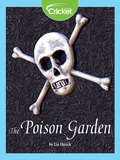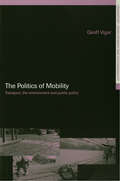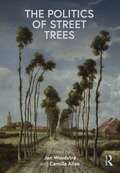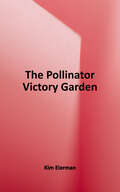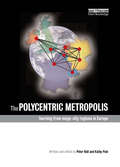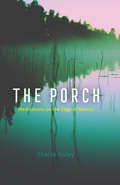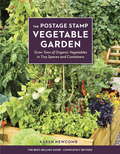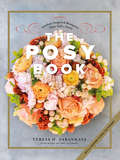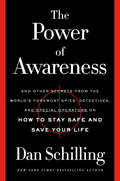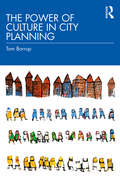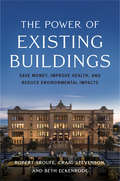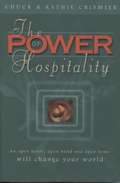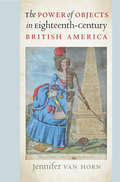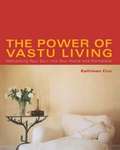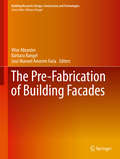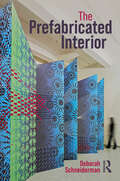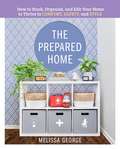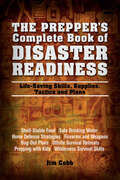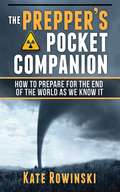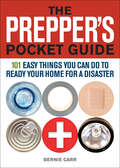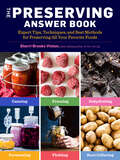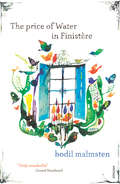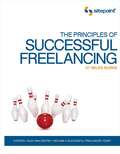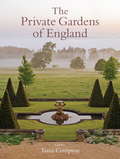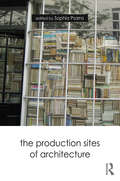- Table View
- List View
The Poison Garden
by Liz HuyckFlowers may look pretty, but some can be downright deadly! In England, you can explore the Poison Garden—a place where flowers are known for their beauty on the outside and poison on the inside! In this story, you'll be able to read about and see these flowers safely without interacting with them.
The Politics of Mobility: Transport Planning, the Environment and Public Policy (Transport, Development and Sustainability Series)
by Geoff VigarTransport issues are critically embedded in everyday life. For this very reason, ways of addressing such issues are almost always hugely politically contentious, as a quick glance at local and national media will testify. Such contentiousness is growing as ever increasing mobility for many in western society has led to a critical examination of the fundamental basis by which transport issues are considered in government and beyond. Despite the strength of this examination, the implementation of new approaches to dealing with transport issues has proved deeply problematic. The Politics of Mobility pioneers a methodological and theoretical framework derived from the social and political sciences to shed light on the complexities of dealing with these issues. It mobilises three case studies that highlight the realpolitik of dealing with such concerns for students, practitioners, researchers and activists.
The Politics of Street Trees
by Jan WoudstraThis book focuses on the politics of street trees and the institutions, actors and processes that govern their planning, planting and maintenance. This is an innovative approach which is particularly important in the context of mounting environmental and societal challenges and reveals a huge amount about the nature of modern life, social change and political conflict. The work first provides different historical perspectives on street trees and politics, celebrating diversity in different cultures. A second section discusses street tree values, policy and management, addressing more contemporary issues of their significance and contribution to our environment, both physically and philosophically. It explores cultural idiosyncrasies and those from the point of view of political economy, particularly challenging the neo-liberal perspectives that continue to dominate political narratives. The final section provides case studies of community engagement, civil action and governance. International case studies bring together contrasting approaches in areas with diverging political directions or intentions, the constraints of laws and the importance of people power. By pursuing an interdisciplinary approach this book produces an information base for academics, practitioners, politicians and activists alike, thus contributing to a fairer political debate that helps to promote more democratic environments that are sustainable, equitable, comfortable and healthier.
The Pollinator Victory Garden: Win the War on Pollinator Decline with Ecological Gardening: How to Attract and Support Bees, Beetles, Butterflies, Bats, and Other Pollinators
by Kim EiermanThis book explains about how you can create a beautiful landscape that attracts and supports many different species of pollinators.
The Polycentric Metropolis: Learning from Mega-City Regions in Europe
by Peter Hall Kathy PainA new 21st century urban phenomenon is emerging: the networked polycentric mega-city region. Developed around one or more cities of global status, it is characterized by a cluster of cities and towns, physically separate but intensively networked in a complex spatial division of labour. This book describes and analyses eight such regions in North West Europe. For the first time, this work shows how businesses interrelate and communicate in geographical space - within each region, between them, and with the wider world. It goes on to demonstrate the profound consequences for spatial planning and regional development in Europe - and, by implication, other similar urban regions of the world. The Polycentric Metropolis introduces the concept of a mega-city region, analyses its characteristics, examines the issues surrounding regional identities, and discusses policy ramifications and outcomes for infrastructure, transport systems and regulation. Packed with high quality maps, case study data and written in a clear style by highly experienced authors, this will be an insightful and significant analysis suitable for professionals in urban planning and policy, environmental consultancies, business and investment communities, technical libraries, and students in urban studies, geography, economics and town/spatial planning.
The Porch: Meditations on the Edge of Nature
by Charlie HaileyCome with us for a moment out onto the porch. Just like that, we’ve entered another world without leaving home. In this liminal space, an endless array of absorbing philosophical questions arises: What does it mean to be in a place? How does one place teach us about the world and ourselves? What do we—and the things we’ve built—mean in this world? In a time when reflections on the nature of society and individual endurance are so paramount, Charlie Hailey’s latest book is both a mental tonic and a welcome provocation. Solidly grounded in ideas, ecology, and architecture, The Porch takes us on a journey along the edges of nature where the outside comes in, hosts meet guests, and imagination runs wild. Hailey writes from a modest porch on the Homosassa River in Florida. He sleeps there, studies the tides, listens for osprey and manatee, welcomes shipwrecked visitors, watches shadows on its screens, reckons with climate change, and reflects on his own acclimation to his environment. The profound connections he unearths anchor an armchair exploration of past porches and those of the future, moving from ancient Greece to contemporary Sweden, from the White House roof to the Anthropocene home. In his ruminations, he links up with other porch dwellers including environmentalist Rachel Carson, poet Wendell Berry, writers Eudora Welty and Zora Neale Hurston, philosopher John Dewey, architect Louis Kahn, and photographer Paul Strand. As close as architecture can bring us to nature, the porch is where we can learn to contemplate anew our evolving place in a changing world—a space we need now more than ever. Timeless and timely, Hailey’s book is a dreamy yet deeply passionate meditation on the joy and gravity of sitting on the porch.
The Postage Stamp Vegetable Garden
by Karen NewcombThis classic gardening bestseller (over 500,000 copies sold) uses ecologically friendly, intensive biodynamic methods to produce large amounts of vegetables in very tiny spaces. Revised for an all new generation of gardeners, the 40th anniversary edition includes brand new information on the variety of heirloom vegetables available today and how to grow them the postage stamp way. To accommodate today's lifestyles, a garden needs to fit easily into a very small plot, take as little time as possible to maintain, require a minimum amount of water, and still produce prolifically. That's exactly what a postage stamp garden does. Postage stamp gardens are as little as 4 by 4 feet, and, after the initial soil preparation, they require very little extra work to produce a tremendous amount of vegetables--for instance, a 5-by-5-foot bed will produce a minimum of 200 pounds of vegetables. When first published 40 years ago, the postage stamp techniques, including closely planted beds rather than rows, vines and trailing plants grown vertically to free up space, and intercropping, were groundbreaking. Now, in an ever busier world, the postage stamp intensive gardening method continues to be invaluable for gardeners who wish to weed, water, and work a whole lot less yet produce so much more.From the Trade Paperback edition.
The Posy Book: Garden-inspired Bouquets That Tell A Story
by Teresa H. Sabankaya“Like a favorite recipe, a posy is meant to be savored and shared. Try it yourself, and … welcome a bit of floral enchantment into your life.” —Amy Stewart, author of The Drunken Botanist Inspired by the Victorian-era language of flowers, a posy is a small, round bouquet of flowers, herbs, and plants meant to convey a message, such as dahlias for gratitude, sunflowers for adoration, or thyme for bravery. These floral poems have become Teresa Sabankaya’s signature. Brides want them for their weddings, but a posy is a lovely gift any time of year, and one that readers can easily put together from their garden or with blooms from their local florist. In The Posy Book, Sabankaya shares step-by-step instructions, floral recipes for more than 20 posies, and ideas for seasonal variations. A modern floral dictionary, with 12 original paintings by celebrated illustrator Maryjo Koch, will help readers craft their own posies filled with personal meaning.
The Power of Awareness: And Other Secrets from the World's Foremost Spies, Detectives, and Special Operators on How to Stay Safe and Save Your Life
by Dan SchillingA spy is suddenly aware she's being stalked through the streets of an overseas city. A special ops soldier intuitively recognizes something's "off" during a high-risk mission. In these life-threatening situations experts know exactly how to use their senses and what actions to take. At the intersection of The Gift of Fear and Make Your Bed, The Power of Awareness will make sure you will, too.In his empowering book, Dan Schilling shares how to identify and avoid threats using situational awareness and intuition just like the pros. Told with wit and wisdom, this compelling guide uses harrowing stories from Dan's special operations career and those of other experts to outline six easily implemented rules you can apply anywhere to improve your personal safety.It incorporates exercises to understand how situational awareness works in real life, how to better listen to your intuition, and when confronted by a criminal how to make a plan and take action with confidence—so you can escape the threat before it's too late.He also includes tools on how to secure your home or hotel room, use public transportation, plan international travel, and reduce your criminal target appeal and exposure, in addition to how to escape an active shooter situation. As a bonus, you'll even learn how to survive a date without getting murdered.By the last page you'll know that your own Power of Awareness can save your life.
The Power of Culture in City Planning
by Tom BorrupThe Power of Culture in City Planning focuses on human diversity, strengths, needs, and ways of living together in geographic communities. The book turns attention to the anthropological definition of culture, encouraging planners in both urban and cultural planning to focus on characteristics of humanity in all their variety. It calls for a paradigm shift, re-positioning city planners’ "base maps" to start with a richer understanding of human cultures. Borrup argues for cultural master plans in parallel to transportation, housing, parks, and other specialized plans, while also changing the approach of city comprehensive planning to put people or "users" first rather than land "uses" as does the dominant practice. Cultural plans as currently conceived are not sufficient to help cities keep pace with dizzying impacts of globalization, immigration, and rapidly changing cultural interests. Cultural planners need to up their game, and enriching their own and city planners’ cultural competencies is only one step. Both planning practices have much to learn from one another and already overlap in more ways than most recognize. This book highlights some of the strengths of the lesser-known practice of cultural planning to help forge greater understanding and collaboration between the two practices, empowering city planners with new tools to bring about more equitable communities. This will be an important resource for students, teachers, and practitioners of city and cultural planning, as well as municipal policymakers of all stripes.
The Power of Existing Buildings: Save Money, Improve Health, and Reduce Environmental Impacts
by Robert Sroufe Jr Craig Stevenson Beth EckenrodeYour building has the potential to change the world. Existing buildings consume approximately 40 percent of the energy and emit nearly half of the carbon dioxide in the US each year. In recognition of the significant contribution of buildings to climate change, the idea of building green has become increasingly popular. But is it enough? If an energy-efficient building is new construction, it may take 10 to 80 years to overcome the climate change impacts of the building process. New buildings are sexy, but few realize the value in existing buildings and how easy it is to get to "zero energy&” or low-energy consumption through deep energy retrofits. Existing buildings can and should be retrofit to reduce environmental impacts that contribute to climate change, while improving human health and productivity for building occupants. In The Power of Existing Buildings, academic sustainability expert Robert Sroufe, and construction and building experts Craig Stevenson and Beth Eckenrode, explain how to realize the potential of existing buildings and make them perform like new. This step-by-step guide will help readers to: understand where to start a project; develop financial models and realize costs savings; assemble an expert team; and align goals with numerous sustainability programs. The Power of Existing Buildings will challenge you to rethink spaces where people work and play, while determining how existing buildings can save the world. The insights and practical experience of Sroufe, Stevenson, and Eckenrode, along with the project case study examples, provide new insights on investing in existing buildings for building owners, engineers, occupants, architects, and real estate and construction professionals. The Power of Existing Buildings helps decision-makers move beyond incremental changes to holistic, results-oriented solutions.
The Power of Hospitality: An open heart, open hand and open home will change your World
by Chuck Crismier Kathie Crismier"God's plan for you includes hospitality. An open heart, open hand and open home is God's divine design to open the hearts of people everywhere it is practiced. Hospitality connects our hearts with God's heart, yet something dramatic has happened in our hearts, closing the doors of our homes, causing Christianity Today to ask, "Whatever Happened to Hospitality?" The Apostle Paul reminds we must all be "given to hospitality." Pastors and leaders must be "lovers of hospitality." And the Apostle Peter declared, "The end of all things is at hand... use hospitality ... without grudging." Here is hidden power reserved by God for those who dare to practice it. It is PERSONAL, it is PRACTICAL, and it is PROPHETIC! The Power of Hospitality will change your life... yes even your family, church, city and world if you will let it."
The Power of Objects in Eighteenth-Century British America (Published by the Omohundro Institute of Early American History and Culture and the University of North Carolina Press)
by Jennifer Van HornOver the course of the eighteenth century, Anglo-Americans purchased an unprecedented number and array of goods. The Power of Objects in Eighteenth-Century British America investigates these diverse artifacts—from portraits and city views to gravestones, dressing furniture, and prosthetic devices—to explore how elite American consumers assembled objects to form a new civil society on the margins of the British Empire. In this interdisciplinary transatlantic study, artifacts emerge as key players in the formation of Anglo-American communities and eventually of American citizenship. Deftly interweaving analysis of images with furniture, architecture, clothing, and literary works, Van Horn reconstructs the networks of goods that bound together consumers in Boston, New York, Philadelphia, and Charleston.Moving beyond emulation and the desire for social status as the primary motivators for consumption, Van Horn shows that Anglo-Americans' material choices were intimately bound up with their efforts to distance themselves from Native Americans and African Americans. She also traces women's contested place in forging provincial culture. As encountered through a woman's application of makeup at her dressing table or an amputee's donning of a wooden leg after the Revolutionary War, material artifacts were far from passive markers of rank or political identification. They made Anglo-American society.
The Power of Vastu Living
by CoxThe Power of Vastu Living introduces a wonderfully accessible, room-by-room approach for organizing and decorating homes, apartments, and work spaces according to the timeless healing principles of vastu -- the sister science of yoga and ayurveda. Kathleen Cox's breakthrough system, Vastu Living, delivers all the practical tools you need to incorporate the organic, soothing properties of ancient vastu design into an increasingly overcrowded, hyper-stressed, and e-saturated world. Now you can create a home for your soul... restore well-being to your work space... celebrate your identity... design your vastu blueprints... ...in every conceivable environment, from the kitchen, living room, home office, and bedroom to the company office, reception area -- and even the dreaded cubicle. Elevate modern life through the 5,000-year-old healing properties of vastu. Enhance your inner peace, rediscover your sense of mind-and-body harmony, and always, always make room for the soul.
The Pre-Fabrication of Building Facades
by Vítor Abrantes Bárbara Rangel José Manuel Amorim FariaThis book compares two buildings with different technologies and distinct environment from the combined viewpoints of civil engineering and architecture. The first is the most recent building of Columbia University in New York, the Northwest Science Building, a project designed by Rafael Moneo and Dan Brodkin of Ove Arup. The second one is the Burgo Tower in Oporto, by Eduardo Souto Moura and Rui Furtado of AFA, a building that brings a new perspective to the use of prefabrication technologies with local traditional construction systems. With the detailed analyses of recognized researchers in civil engineering and architecture, this book is a reflection upon the problems and solutions in the design and construction process of a prefabricated building system. This volume, like those to follow, brings together, building research and building design practice to enhance the knowledge of complementarity areas involved in construction, engineering and architecture. This is the first book in a new series "Building Research: Design, Construction and Technologies" which aims to bridge scientific research and professional practice to understand the Building Design problems. In each edition, one or two case studies (recognized buildings in the international design panorama) are analyzed with their authors to assess the design process and the construction development. To understand the problems involved, researchers, engineers and architects, are asked to contribute to this ana lysis with essays on building research issues, as building technology, construction management, acoustics, maintenance or prefabrication.
The Prefabricated Interior
by Deborah SchneidermanThough much attention has been given to the prefabrication of architecture, there has been little discussion on the influence and importance of prefabrication within the interior environment.This book does just that, providing a comprehensive investigation into the prefab interior from the 19th century to the present and beyond. Each chapter focuses on a typology of the prefabricated interior, looking at the bathroom, kitchen, workspace, furniture, mobile interiors, the prefab house, textiles, wearables, and the digital realm of printed interiors. Taken as a group, these chapters and illustrations indicate that constructs of the interior have been pivotal in the generation of techniques and processes of prefabrication in architecture and the built environment. Chapters explore a diverse range of examples of innovative prefabricated elements and assemblages within interior environments, illustrating the inherent sustainability, accessibility, building efficiency, and affordability of prefabricated design.The culmination of a decade of research by the leading expert on the topic, this will be the go-to resource on prefabricated interiors and an important read for all students and researchers in interior design.
The Prepared Home: How to Stock, Organize, and Edit Your Home to Thrive in Comfort, Safety, and Style
by Melissa GeorgeTurn your home into a sanctuaryWhen your home is ready for the many surprises life can bring, your whole family can enjoy everyday moments and stay at their best. Whether there’s a power outage, the Wi-Fi goes out, or you are asked to quarantine, The Prepared Home is designed to help you plan and reach preparedness goals without letting them take over your space and your life. It’s your full-color guide to a stylish home that feels like a sanctuary in normal and in challenging times. You’ll discover how to . . .·Transform your home from entertaining mode to disaster-ready mode quickly and easily·Discover clever and aesthetically pleasing ways to store emergency items ·Assess your risks and stock up on all the right things for your householdThe Prepared Home by Melissa George is just what you’ve been looking for to prioritize your needs and take steps to make your home a place of safety, comfort, and beauty!
The Prepper's Complete Book of Disaster Readiness: Life-Saving Skills, Supplies, Tactics and Plans (Preppers)
by Jim CobbMake sure your survival plan is complete from A to Z with this comprehensive disaster prep guide. When preparing to face a disaster scenario, details can mean the difference between life and death. If you overlook one vital area, fail to stock one supply or underestimate one potential danger, your whole plan could come crashing down. The Prepper&’s Complete Book of Disaster Readiness guarantees you won&’t miss a thing as you prepare to face the most critical challenges. This bible of prepping shows each and every life-saving step necessary to keep your family alive and well when the world around you is in chaos, including how to: • Efficiently store water and acquire additional fresh water after a collapse • Build a shelf-stable food stock and supplement it by harvesting edible wild plants • Strengthen the security of your home as well as have a back-up bug-out plan • Treat illness and stay healthy when there are no doctors or hospitals • Build a safe and secure survival retreat that allows for long-term off-the-grid living
The Prepper's Pocket Companion: How to Prepare for the End of the World as We Know It
by Kate RowinskiMost people don't believe they will ever have to face a real disaster, or are too scared to look ahead and quickly dismiss any thoughts of a future catastrophe. But a cataclysm can happen in an instant and without warning, and you won't be able to save yourself if you are not prepared. The Prepper's Pocket Companion shows you what to do before, during, and after any disaster, whether big or small. With ten easy steps, you'll learn the basics of: -Creating a foolproof plan -Storing water and food -Cooking off the grid -Alternative energy sources -Various disasters you may encounter -Short-term and long-term self-sufficiency -Safe and fast evacuation -And much more With this handy and instructive guide, you will learn how to protect yourself, your family, neighbors, and pets and be completely ready to face any disaster that may strike.
The Prepper's Pocket Guide: 101 Easy Things You Can Do to Ready Your Home for a Disaster (Preppers)
by Bernie CarrStay safe and be prepared for any disaster with this DIY guide featuring 101 easy prepper projects and practical survival skills.From California earthquakes and Rocky Mountain wildfires to Midwest floods and Atlantic hurricanes, you can’t escape that inevitable day when catastrophe strikes your home town — but you can be prepared! Offering a simple DIY approach, this book breaks down the vital steps you should take into 101 quick, smart and inexpensive projects. With the Prepper’s Pocket Guide, you’ll learn to:#6 Make a Master List of Passwords#16 Calculate How Much Water You Need#33 Start a Food Storage Plan for $5 a Week#60 Make a Safe from a Hollowed-out Book#77 Assemble an Inexpensive First Aid kit#89 Learn to Cook Without Electricity#94 Pack a Bug-out Bag
The Preserving Answer Book: Expert Tips, Techniques, and Best Methods for Preserving All Your Favorite Foods
by Sherri Brooks VintonIn this comprehensive guide, expert author Sherri Brooks Vinton answers the home preserver&’s most commonly asked questions about every aspect of food preservation, from refrigeration and freezing to canning, drying, and fermenting all kinds of fruits and vegetables. She also offers tips and techniques for setting up your kitchen, choosing the preserving process that best suits your needs, making equipment and ingredient substitutions, and much more. Whether you&’re new to preserving or just looking to refresh your memory at the start of the season, whether you want to know the difference between jam and jelly or which varieties of tomatoes are best for canning, you&’ll find the information and confidence you need with this kitchen companion in hand. This publication conforms to the EPUB Accessibility specification at WCAG 2.0 Level AA.
The Price of Water in Finistère
by Bodil Malmsten'In the same way as there's a partner for every person, there's a place. All you have to do is find the one that's yours among the billions that belong to someone else, you have to be awake, you have to choose.' With this conviction in mind, acclaimed Swedish writer Bodil Malmsten abandons her native country at the age of fifty-five and settles in Brittany. At the heart of this memoir is the conviction that the happiness to be found in Finistère will not allow itself to be, cannot be, expressed in writing. Embroidered around this seeming paradox are poignant, outraged and thought-provoking observations on the widest range of subjects: how not to buy plants, the elicit pleasures of bargain-hunting, the misery of writer's block, social democracy, racism, tulipomania, the stubbornness of bank managers, the controlling of moles and slugs, death, political hypocrisy, the delights of wild weather. Malmsten's passion and humour shine through every episode she describes, however minor, offering the reader a window onto a solitary life at once touching, thought-provoking and, occasionally, hilarious.
The Principles of Successful Freelancing
by Miles BurkeThinking about becoming your own boss and embarking on the wonderful and rewarding journey of freelancing? The Principles of Successful Freelancing is for you. In this easy-to follow guide you'll learn what's important in transforming your skills into a booming freelance business. This book leads you through the entire process, from getting started, through to winning and keeping loyal clients. Running a successful freelance business is easy, and with the information in this book, you'll confidently turn your freelancing dream into a profitable reality. Learn how to make a smooth transition into freelancing Understand how to effectively manage your money Ensure you spend your time on the right activities Discover why a work/life balance is important Learn how your network can support you and your business Overcome your fear of selling And much more . . . The 12 Principles Of Successful Freelancing Get Organized Keep your workspace tidy and plan ahead(short- and long-term). Control Stress Remain calm and work through issues to avoid early burnout. . Research Spend quality time researching your proposed business-it's more than a five minute web surf. Be Passionate Love your work! You should enjoy what you do for a living. Budget Save for a rainy day rather than spend every cent as it comes in. Value your Health Bad health stops you from working. Take time to exercise and maintain a nutritious diet. Embrace Selling Enjoy the sales challenge-it's easier than you think! Satisfy Customers Don't do average work-exceed their expectations and make them need you. Grow Your Network Value family and friends' support, and meet new people all the time. Maintain Cashflow. It's what is in the bank that counts, not what you are billing-understand the difference. Continually Learn Keep acquiring new skills and knowledge, every week. Let it slip and you could be left behind. Achieve a Work/Life Balance Your life should be more than work-maintain a good balance for health and success.
The Private Gardens of England
by Tania ComptonThe Sunday Times Gardening Book of the YearDescribed by Vogue as 'the revelatory garden book for our age' and a 'splendid new book' (Sebastian Shakespeare, Daily Mail), The Private Gardens of England is a glorious celebration of the art of gardening through some of the country's hidden horticultural jewels.Thirty-five English private gardens, thoughtfully selected by the writer and designer Tania Compton, are vividly described in the words of their owners, who bring an astonishing sense of intimacy to their own creations as well as their collaborations with some of the leading garden designers of today.From the Bannermans' romantic Cornish castle to the windswept shores of Howick in Northumberland via Jasper Conran in Somerset and Tom Stuart-Smith in Hertfordshire, an eclectic range of gardens is revealed. The traditional English garden is seen through the fresh eyes of plantswomen such as Mary-Anne Robb at Cothay Manor and Arabella Lennox-Boyd at Gresgarth Hall, alongside Hilborough House in Norfolk and Ferne Park in Dorset that recently only existed as fields. The historic landscape gardens of Boughton House and St Paul's Walden Bury are explored alongside the contemporary and conceptual at Plaz Metaxu in Devon. From the private walled garden at Petworth to the wildflower-strewn meadows of Spye Park, each garden is a testament to the thriving art of English gardening.With contributions from the country's best garden photographers, The Private Gardens of England reveals gardening at its highest level. It will inform and inspire anyone with a love of gardening, beauty and excellence.'The photographs are take-your-breath-away spellbinding . . . The minute level of detail here will satisfy real gardeners, elevating this book far above its competition.' Sarah Feeley, English Garden'Captures a brilliant moment in our history, where plantsmanship, good design and love of plants have all come together . . . compelling format . . . the photography and production are superb.' Kathryn Bradley-Hole, Country LifeOne of Christopher Woodward's Books of the Year in the Evening Standard
The Production Sites of Architecture
by Sophia PsarraThe Production Sites of Architecture examines the intimate link between material sites and meaning. It explores questions such as: how do spatial configurations produce meaning? What are alternative modes of knowledge production? How do these change our understanding of architectural knowledge? Featuring essays from an international range of scholars, the book accepts that everything about the production of architecture has social significance. It focuses on two areas: firstly, relationships of spatial configuration, form, order and classification; secondly, the interaction of architecture and these notions with other areas of knowledge, such as literature, inscriptions, interpretations, and theories of classification, ordering and invention. Moving beyond perspectives which divide architecture into either an aesthetic or practical art, the authors show how buildings are informed by intersections between site and content, space and idea, thought and materiality, architecture and imagination. Presenting illustrated case studies of works by architects and artists including Amale Andraos, Dan Wood, OMA, Koen Deprez and John Soane, The Production Sites of Architecture makes a major contribution to our understanding of architectural theory.
